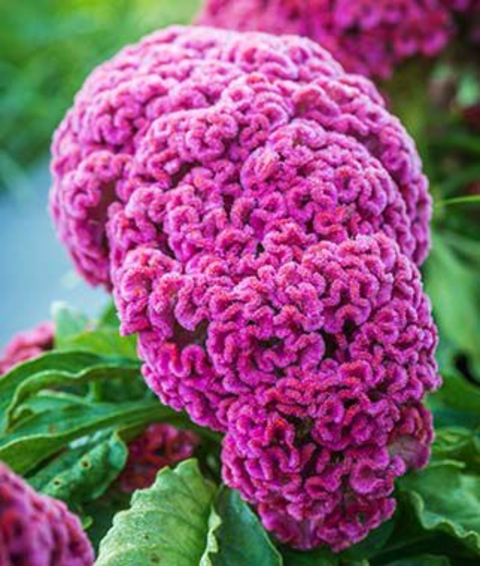Quick facts
- Celosia are low maintenance plants that do best in garden beds rather than containers.
- Celosia prefer full sun and well-drained soil.
- They can be started from seed or from cuttings.
- Three distinct types: plumed, wheat and cockscomb.
- Celosia provide abundant blooms all season long.
- Common floral colors: Purple, red, orange, yellow, white, pink, maroon.
- Common foliage colors: Blue/green, purple/burgundy, chartreuse/gold.
Celosia is a member of the amaranth family and is a very common plant in Minnesota annual gardens due to their ease of care and wide array of flower structures and colors.
The name Celosia originates from the Greek word for “burning” due to the flame-like flower heads. The species used for flowering annuals is believed to be native to the Mediterranean region or East Africa and also commonly known as “woolflowers”.
Leaves of this plant are edible and have a spinach-like taste while the plant is young but after flowering, the leaves turn bitter.
There are three distinct types of Celosia based on flower structure: plumed, wheat and cockscomb.
- Plumed cultivars have multiple flower stalks and blooms with a feathery appearance. They are often between 8 and 24 inches tall.
- Wheat cultivars have a singular flower stalk and are similar looking to the head of a grain crop. These cultivars are often between 12 and 36 inches tall and are the most limited in colors compared to the plumed and cockscomb varieties.
- Cockscomb cultivars have coral or brain-looking blooms that are often large and heavy so they must often be staked. They grow between 12 and 36 inches tall.
Recommended varieties
Annual celosia are evaluated as part of the U of M flower trials and research. Located at the WCROC in Morris, MN, the Horticulture Display Garden serves as an All-America Selections (AAS) Display Garden and Trail Grounds and provides the public an opportunity to view the newest superior performers.
The following annual celosia cultivars were rated good to excellent in our recent trials:
- Asian Garden
- Smart Look Red
- Prestige Scarlet
- New Look™
Growing outdoors
Celosia perform best in garden beds and will often be stunted if grown in containers. They can be planted outdoors once soil temperatures are above 55 degrees Fahrenheit. Plants should be spaced about 8-12 inches apart depending on cultivar. These are the following requirements for choosing a site for celosia:
- Must have full sun for 8+ hours a day. They perform best in a very warm location.
- Soil must be well drained. To improve drainage, compost or sand can be incorporated into heavy soils.
- Celosia prefer soils with a pH of 6-6.5 with a high organic matter content.
A general-purpose fertilizer with equal amounts of Nitrogen, Phosphorus, and Potassium should be incorporated into the soil at time of planting. After planting, celosia should be fertilized monthly using a fertilizer with a higher phosphorus than nitrogen content to promote new blooms.
Celosia require regular watering but do not overwater as they can tolerate dryer soil better than overly wet soil and too much water can kill the plant. Only water when the top 1-2 inches of soil are dry.
Pests and diseases are usually not an issue with this plant.
Other tips for abundant blooms and healthy plants:
- Stake taller cockscomb varieties to prevent the stem from breaking as the large flower head develops.
- Removing old blooms from the plant will promote the production of new flowers.
- Keep the soil surface clean to prevent the growth of disease.
Starting seeds indoors
Celosia seeds can be started indoors about 10 weeks prior to the anticipated outdoor planting date. Use a growing media specifically designed for germinating seeds. Follow these guidelines for successful seed propagation:
- Plant ¼ inches deep and cover with vermiculite.
- Keep the seed and media moist by using a plastic cover over the seeding tray.
- Seeds will germinate in 7-10 days at 75-80°F
- After germination, grow plants at 70-75°F during the day and 65-70°F at night.
- Celosia seedlings are very susceptible to dampening off so let media dry out slightly between waterings.
Flower displays
Celosia are often used in cut flower displays, both fresh and dried. To keep fresh cut flowers displays looking their best, be sure to change the water every two days. To dry celosia flowers, hang them upside down for two weeks.
Celosia propagation
Celosia are easily propagated via cuttings as well in about 3-4 weeks. To do this, cut 4-6 inches off the top of the plant and then remove the leaves off the bottom half of the cutting. Place the cutting in enough water to cover where the leaves were removed. Once roots begin to grow, it can be transplanted into soil.
Reviewed in 2021







